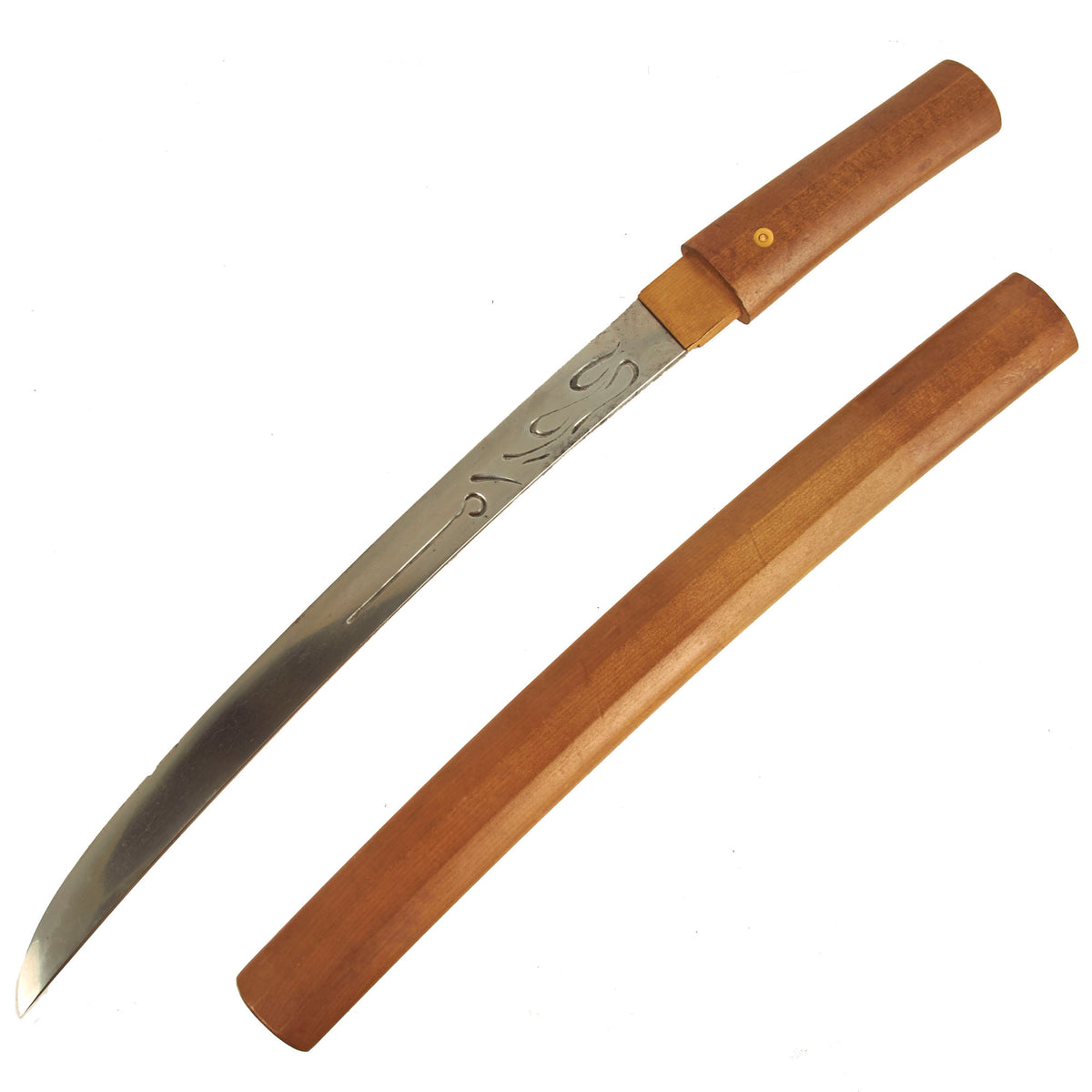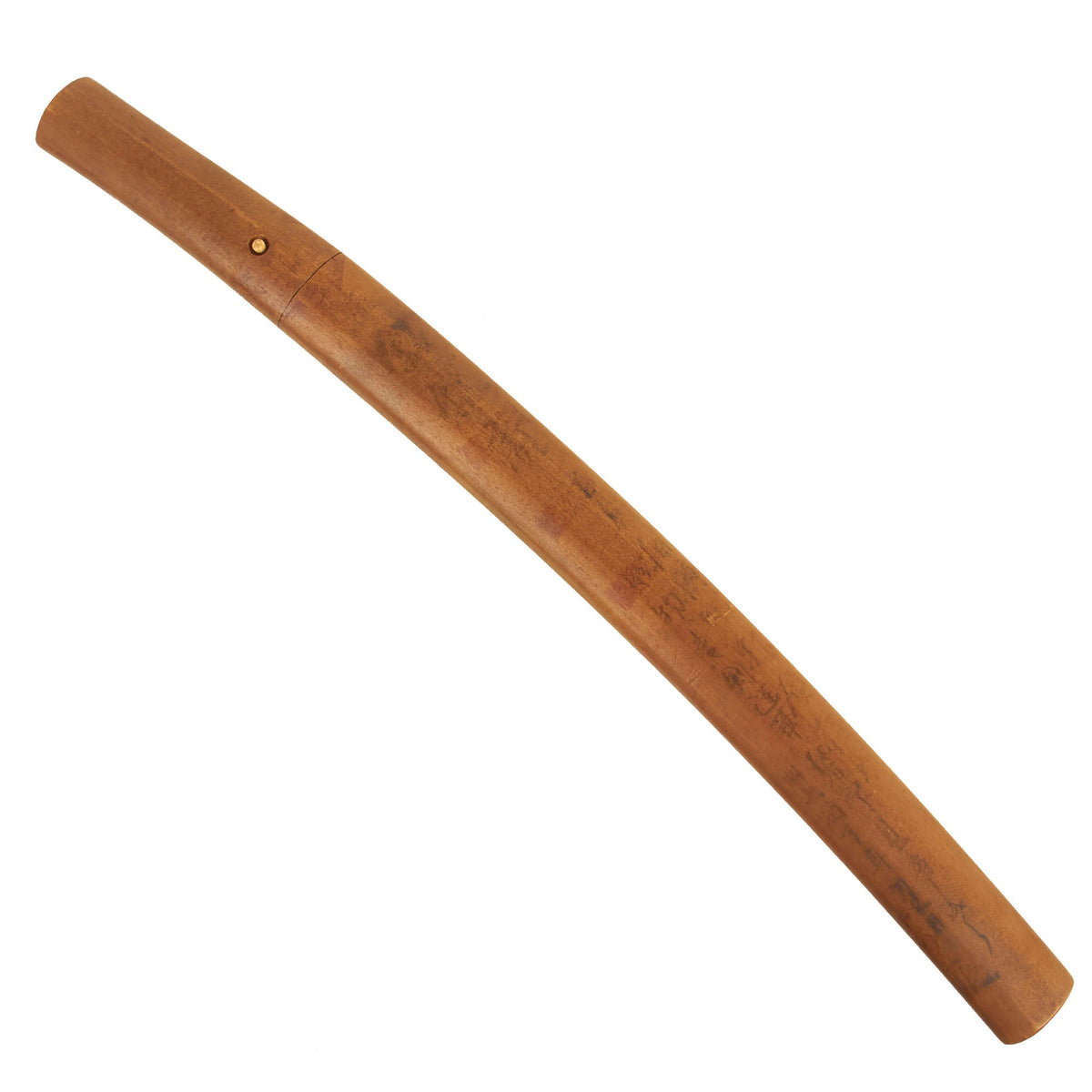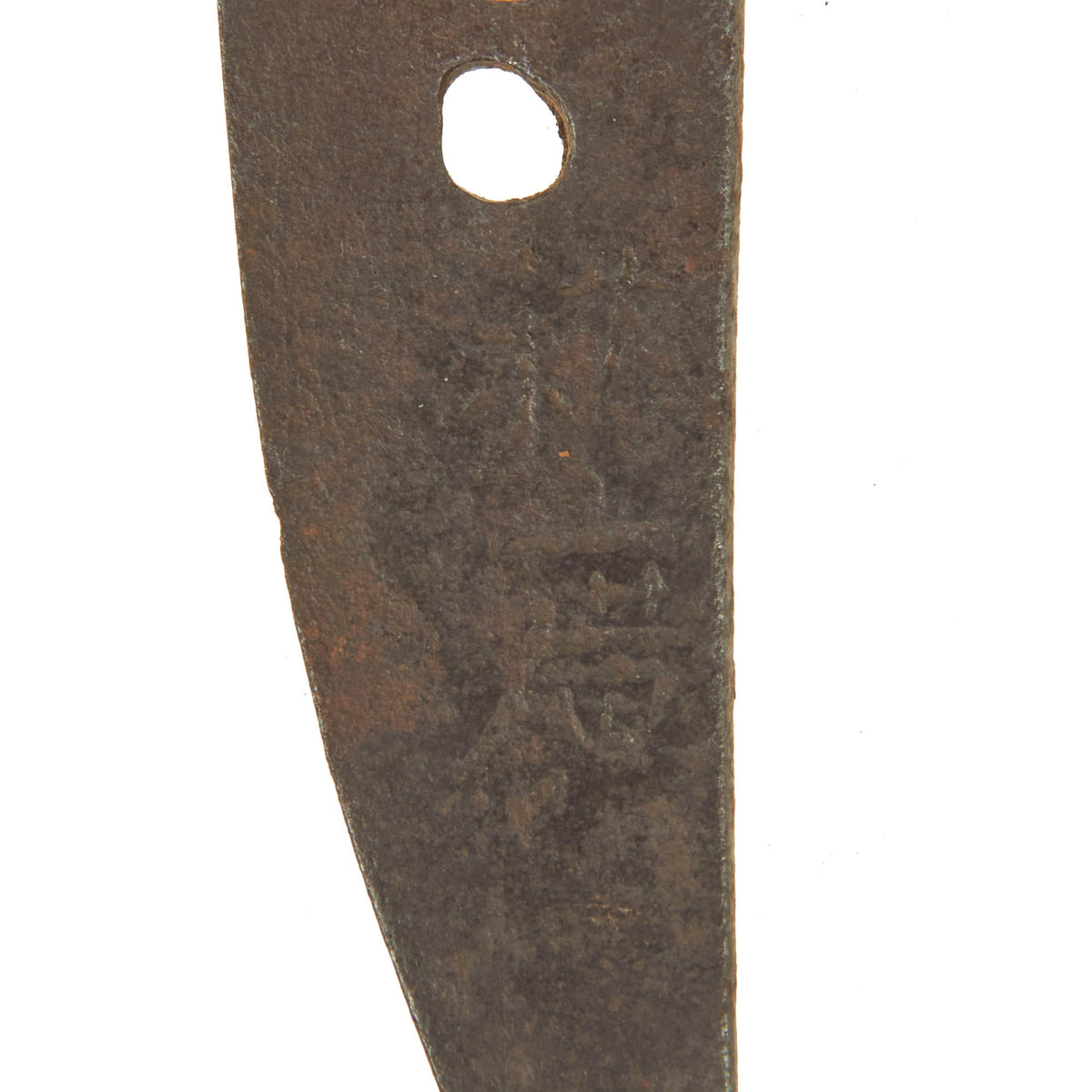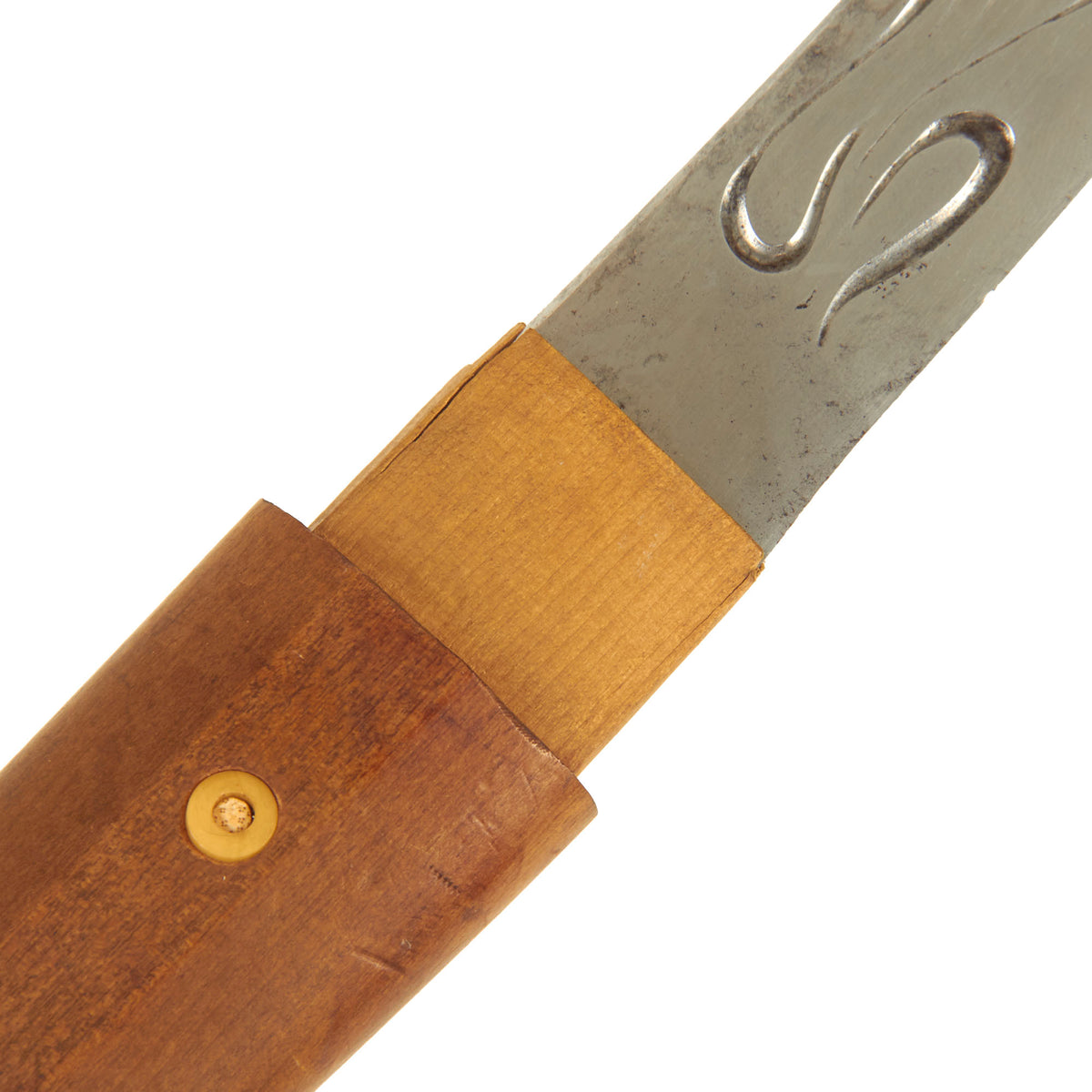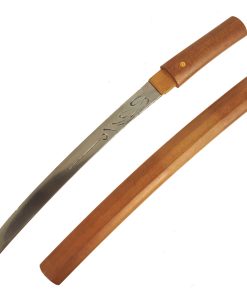Original 14th Century Japanese Wakizashi Short Sword by 2nd Gen SOSHU-DEN AKIHIRO in Resting Scabbard Original Items
$ 1.795,00 $ 448,75
Original Item: Only One Available. Wakizashi (脇差 “side inserted / companion sword”) is a general term for a sword between one and two shaku long (30 cm and 60 cm). Generally it is the short blade that accompanies a katana in the traditional samurai daisho pairing of swords, but may be worn by classes other than the samurai as a single blade, also worn edge up as the katana.
As best we can tell, this example dates from the Muromachi period (室町時代 Muromachi jidai) of 1336 to 1573, most likely the earlier portion. This is part of the period of Japanese swordmaking known as Kotō (古刀”old swords”), the the type of swords that later smiths treated as the goal they needed to achieve.
This example has definitely been remounted several times, as was common for Japanese blades that are several hundred years old. It had an additional hole added in the tang, and was later put into a “resting scabbard” for long term storage. Age and wear have made the file marks (yasurimi) on the tang faint, and given it a lovely patina. This has however also made the mei, or signature on the blade harder to read, and removed the tagane (chisel marks) and tagane-makura (raised area around the mei).
As best we can tell, the blade is signed 秋 廣 – AKIHIRO, a legendary name in Japanese swordmaking. Based in Sagami Province (相模国, Sagami no kuni), also called Soshu (相州), there were several generations of smiths using this name, with the first being a student of Masumune (正宗), Japanese greatest swordsmith. While not one of the “Ten Famous Students”, Akihiro worked with Hiromitsu (another Masamune student) to refine the SOSHU DEN (相州 伝 – Soshu School) style into “second period” of sword making. There were at least 4 Generations using this name, all of which were highly ranked. Based on the characteristics of the blade, it is estimated that the second generation Akihiro forged this blade when they were active during the Tenju (天授) period, which lasted 1375 to 1381.
Of note is that the with the influence from Akihiro and Hiromitsu, the Soshu School was able to be counted as one of the Goka Den (五家伝 – The primary five schools) of Japanese swordmaking, along with the Yamashiro, Bizen, Yamato, and Mino schools.
The blade is really a nice example, has the following period correct features:
– Folded steel blade (fold lines are evident on the spine and body of the blade)
– holes in the tang (mekugi-ana) are punched and not drilled
– blade is signed on the tang by the maker
– blade has a temper line (hamon), which is easily visible and vibrant.
– Blade wounds (kizu) or lamination artifacts are present on the blade, only possible on traditionally made examples. These are mostly WARE (lamination lines).
– Grain (hada) is visible in the body of the blade, only possible with laminated steel blades.
The blade of this example is 15 inches long, and the overall length of this wakizashi is 21 3/4 inches in the resting handle. The polish on the blade is very good condition, which allows the aspects of the blade to easily be seen. There is a bit of light oxidation staining in areas. The edge is still quite sharp, however it does have two chips on the edge, with the larger being 6mm long and about 1mm deep, and it does not go through the hamon. The blade shape is HIRA ZUKURI (平造), which means that the blade does not have a SHINOGI (blade ridge), and is flat on the sides. It also means that there is no YOKOTE separating the rest of the body from the KISSAKI (tip). It has a beautiful tapering shape, like a leaf from the Japanese iris or hanashōbu (花菖蒲). This is a shape often used on shorter Wakizashi as well as Tanto knives. Some would term this is a Ko-Wakizashi as it is shorter, and very much resembles a long tanto.
The tang (nakago) is of the FUNAGATA – (舟形 – ship bottom shape) style, with a KURI-JIRI (栗尻 – symmetrical Rounded) nakago-jiri. This usually only seen on very old blades such as this. The hamon (temper line) is clearly visible, and is a beautiful GUNOME-MIDARE (互の目乱れ – irregularly undulating) shape, with lots of internal activity. It also shows aspects that resemble other styles of temper lines. NIE Crystals are visible, and there is NIOI cloudiness visible with lamination lines. The blade also has some lovely flame shaped HORIMONO (彫物), which are carved designs on the sword blade, which really add to the appearance.
The body of the blade shows ITAME HADA (板目肌 (wood grain), which is quite pronounced, so it might be termed O-ITAME (large wood grain). The boshi is visible, and is a KOMARU (小丸 – small round turnback) type, and there is correctly no YOKOTE on this blade. There are also some WARE lamination lines and small FUKURE carbon pits visible, only possible on traditionally made blades. With the long delay for traditional togishi polishing, blades like this that are ready to display are definitely in demand.
This sword is mounted in a “resting scabbard” or Shirasaya, which is intended for storing the blade when it is not in use. It is in very good condition, and looks to be relatively old, probably from the early 20th century, and the wood has matured to a lovely chestnut color. The seams are still secure, with no splitting visible, and there is some old Japanese writing on the scabbard, though it is unfortunately way to faded to read. The TSUBA has an attached wooden HABAKI (blade collar) on the top. It has a fitting around the mekugi-ana (peg hole) on one side, while the other is missing, and the cross pin looks to be a recent replacement.
A lovely Muromachi period Ko-wakizashi by a famous lineage of makers in the legendary Soshu school of Sagami province, ready to display!
Specifications:
Blade Length: 15″
Blade Shape: – Hira Zukuri
Overall length: 21 3/4“
Scabbard Length: 16 3/4″
It has been over one thousand years ago that the art of making swords appeared in Japan. The swordsmiths of the time may not have known it but they were creating a legendary sword. The Samurai sword has seen combat in many battlefields. From the early days of the Samurai warrior to the fierce battles in the South Pacific during WWII.
Each hand-made Japanese blade (日本刀 – Nihonto) is unique because it is forged from multiple pieces of folded steel stock. A tremendous amount of work is dedicated to creating these pieces. They were an instrument of war as much as a beautiful artifact to adorn a room.
The traditional Japanese blade and mountings have grown to be one of the most highly desired military antiques.
Fast Shipping with Professional Packaging
Thanks to our longstanding association with UPS FedEx DHL, and other major international carriers, we are able to provide a range of shipping options. Our warehouse staff is expertly trained and will wrap your products according to our exact and precise specifications. Prior to shipping, your goods will be thoroughly examined and securely secured. We ship to thousands clients each day across multiple countries. This shows how we're dedicated to be the largest retailer on the internet. Warehouses and distribution centres can be located throughout Europe as well as the USA.
Note: Orders with more than one item will be assigned a processing date depending on the item.
Before shipping before shipping, we'll conduct a thorough inspection of the items you have ordered. Today, the majority of orders will be delivered within 48 hours. The delivery time will be between 3-7 days.
Returns
The stock is dynamic and we cannot completely manage it because multiple stakeholders are involved, including our factory and warehouse. So the actual stock may alter at any time. It's possible that you may not receive your order once the order has been made.
Our policy is valid for a period of 30 days. If you don't receive the product within 30 days, we are not able to issue a refund or an exchange.
You can only return an item if it is unused and in the same state as the day you received it. You must have the item in its original packaging.
Related products
Uncategorized
Uncategorized
Uncategorized
Uncategorized
Uncategorized
Band of Brothers ORIGINAL GERMAN WWII Le. F.H. 18 10.5cm ARTILLERY PIECE Original Items
Uncategorized
Uncategorized
Uncategorized
Uncategorized
Uncategorized
Uncategorized
Uncategorized
Uncategorized
Uncategorized
Australian WWII Owen MK1 Machine Carbine SMG Custom Fabricated Replica with Sling Original Items
Uncategorized
Uncategorized
Uncategorized
Uncategorized
